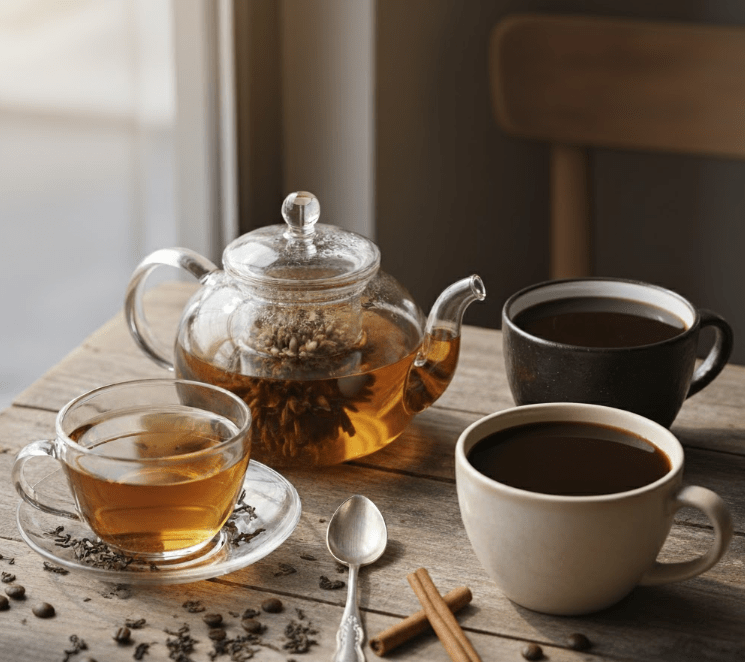So coffee or tea which is better to drink?
Winter is already here.
Some days are cold and rainy, others sunny and warm.
Either way, it seems that people drink less in winter and there is a preference for hot drinks, perhaps even warming.
One of the decisions that repeats more than once a day, especially on winter days at home, at work, or at a cafe, is what to drink. Hot or cold? Coffee or tea? Some prefer coffee and tea is not an option at all.
Others the exact opposite: only tea, no dilemma.
And there is a third option: half tea, half coffee.
Either way, this is an opportunity to consider winter drinks in general and compare the two “competing” beverages, coffee vs tea.
Tea is perceived as calming coffee as stimulating.
For some, tea is seen as healthy and coffee as unhealthy and should be limited if at all.
The question of coffee or tea has a long history.
They tell of Gustav III, King of Sweden in the 18th century, who was worried about which was healthier for him coffee or tea?
He found an original way to check.
The king chose two death row prisoners, twins and commuted their sentences to life imprisonment.
One twin had to drink coffee daily, the other tea.
It was a lifetime task.
Gustav III also chose two doctors to follow the twins and see which brother would live longer. Ironically, the two doctors died first, then the king (who was assassinated).
After all three, the tea-drinking prisoner died at 83 and last was his brother who drank coffee.
Although not a controlled clinical experiment in an academic setting, it mainly shows the curiosity these drinks have always aroused and the desire to answer the question of which is better.
Hundreds of years later with hundreds of controlled studies on coffee and tea what do we know today?
Tea and coffee are ancient and beloved drinks, with a rich culture and a wide variety of types and flavors. Tea originates in China or India and it has undergone significant development over the years. It is made from Camellia sinensis leaves and exists in many forms such as white, green, oolong and black tea, each characterized by a different production process.
Coffee, on the other hand, originates in Ethiopia and is made from coffee plant beans.
There are dozens of coffee bean varieties, with the most common being Arabica and Robusta.
The first is more delicate and slightly acidic, the Robusta strong and bitter.
Several steps of processing the beans precede sipping a cup of coffee.
After about four years, the coffee tree produces red cherry like fruits, whose seeds are the beans and the tree will yield fruits for about 40 more years.
After collecting and drying the fruits, the outer skin is removed to reveal green beans.
They go through sorting and tasting followed by roasting, which significantly affects flavor, aroma and brown tones.
Then they are ground, enhancing the smell and taste.
Coffee and tea contain many nutritional components, with two attracting particular health, scientific, and media interest: caffeine and antioxidants.
Caffeine: Effects last up to five hours
Caffeine, an active component found in coffee, tea leaves, cocoa, chocolate, soft drinks, energy drinks, and surprisingly, also in some medications, such as pain relievers or cold medicines.
Caffeine is known as a stimulant, increasing concentration and alertness, especially when tired. Perhaps this explains the common habit of starting the morning with coffee and drinking coffee during tired hours like afternoon or evening without even thinking about it.
Caffeine also improves physical performance by stimulating metabolism and delaying fatigue.
It is absorbed quickly, usually within 30 minutes, and its effect lasts 2–5 hours.
However, these benefits can also be a disadvantage in some cases.
This is why it is recommended to avoid caffeine-containing drinks near bedtime.
It is important to understand that caffeine’s effect varies from person to person.
Health organizations worldwide usually recommend moderate consumption, about 300 mg of caffeine per day.
In a cup of black coffee: 150–200 mg, instant coffee: 50–100 mg, depending on the type of coffee and caffeine content per serving.
Black tea and green tea also contain caffeine, but the difference is in quantity: 40–50 mg in a regular cup of tea, depending on concentration and 15–20 mg in a cup of green tea.
Some population groups must limit caffeine intake, such as those with high blood pressure, asthma (taking aminophylline medications), caffeine sensitivity, pregnant women and children due to lower body weight.
Limiting caffeine usually corresponds to the amount in two cups of coffee, and in some cases, complete avoidance is required.
Strong in antioxidants
Antioxidants extend the life of cells and protect them from free radical damage.
Free radicals are produced in the body from exposure to pollution or smoking, attack cells, and may cause disease.
Antioxidants – found in food, mainly fruits and vegetables, and drinks like coffee and tea – strengthen the body’s natural defense.
Coffee contains phenols and chlorogenic acid antioxidants, black tea contains flavonoids and catechins.
Green tea also contains EGCG, another strong antioxidant.
Eastern cultures use green tea for its health properties and scientific studies confirm its contribution to weight loss, cholesterol balance and reduced risk of heart disease.
Coffee and black tea contribute significantly to dietary antioxidant intake due to widespread consumption.
Since the variety of antioxidants differs between coffee, black tea and green tea, from a nutritional and health perspective, it is best to vary drink types to get a wide range of antioxidants and broader disease protection.
However, green tea has an advantage, as its antioxidant content is especially high and caffeine content is lower, so it is recommended to drink more of it.

